#you get to train in many medium and art styles and experiment
Explore tagged Tumblr posts
Text
also while im at it, those who follow my main account probably heard me talking about an ARPG (art role play group) on Deviant Art im in, called Grimsby Grove, with a semi closed evoluting species, and sometimes i have fun making fake designs for arknights characters because the brainrot is just too strong and i get funny ideas with the mechanisms and stuff available in the group
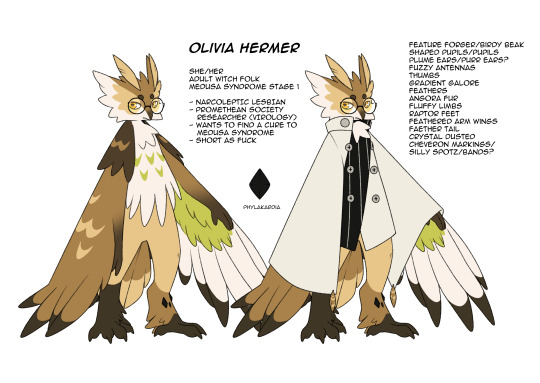
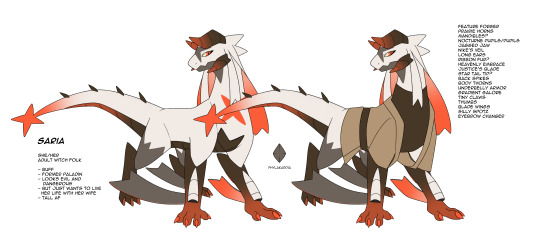
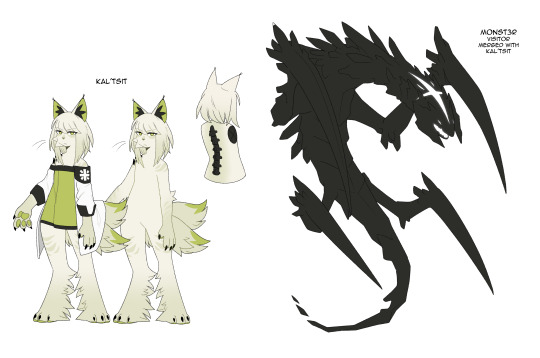
currently the group is closed because of halloween event happening (which is why i am very busy art wise, i have so much on my plate), but the discord is still open and u can hang out there if u wanna, i will pass say hello
#arpg groups are really cool because due to the requirements and prompts you have to do#you get to train in many medium and art styles and experiment#like for this month one of the prompt is to do pixel art or a lantern craft#i think its really cool and those helped me a lot to experiment stuff#plus gg is managed by friends they r cool and you have a ton of freedom in the designs and lore#anyway its cool#arknights#stalkiwiart#olivia silence#saria#kal'tsit#(i put more info in the image descriptions if u wanna understand the stuff i wrote on the pics)
230 notes
·
View notes
Text
Some thoughts on Metaphor: ReFantazio. I avoid spoilers for the most part.
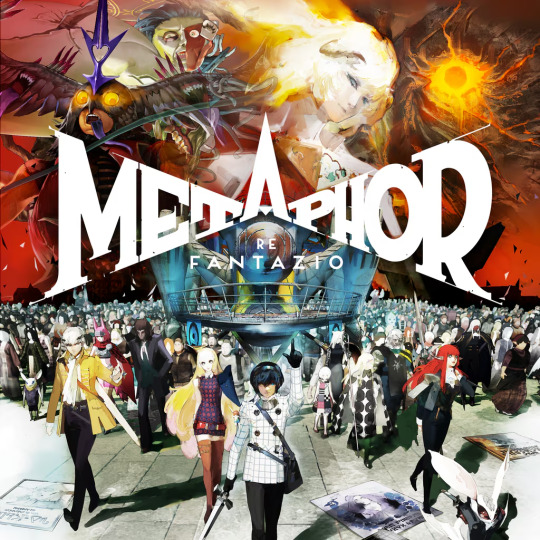
It’s maybe impossible to overstate how much I love Persona 5. It’s my favorite game of all time, and directly started me down the path to being a radical. It’s got some flaws – many of which were fixed in its rerelease, Persona 5: Royal – but it’s such a fantastic package in terms of story, gameplay, art design, music, and thematic resonance that it’s hard to fault it for them. I’ve played and enjoyed subsequent P5 material, but none of them are nearly as devoted to a political message as the original, meaning that even though they’re all good, they ultimately fall short of what I love about the initial game.
Metaphor: ReFantazio is a 2024 RPG by a good number of the folks who made Persona 5, and you can immediately tell. It has a very similar art style, uses many of the same sound effects, has a similar battle system, and is built around the calendar/social links/social stats system that the Persona series is known for. It is essentially a Persona game, but set in a fantasy world rather than contemporary Japan, and without Persona’s emphasis on Jungian psychology and the tarot. It’s also thoughtfully political, but in a way that’s maybe less engrossing and blisteringly relevant than Persona 5. That said, what it does have to say is worth engaging with, as it uses its more traditional fantasy setting to comment on the ideological underpinnings of RPGs as a genre and games more broadly, as both an artistic medium and an industry.
In many ways, Metaphor is “Persona does Final Fantasy.” It’s clearly an homage to Final Fantasy at its core. It may have Persona 5’s battle system, but it’s got FFV’s job system, and it’s reworked the “one more” mechanic to feel more like the Brave/Default system from Bravely Default, or the Conditional Turn-Based system from Final Fantasy X. The job system is especially interesting. There are 14 basic jobs, with each job having 1-3 class change upgrades that unlock at specific Social Link levels with the job’s corresponding character. Every party member can use any job, but have very individualized stat spreads that make certain jobs more viable than others. For example, Strohl starts with the Warrior job, which hits hard and doesn’t do much else. He could use the Mage job, but his physical attack is like double his magic attack, so that would probably be a waste of his massive attack stat. That said, some players might opt to train him through Mage anyway, because at level 20, Mage gets a skill that increases MP by 15%, which they could equip to Warrior so he can use more of his big hits that spend MP. I, on the other hand, trained him in Pugilist, which has powerful physical moves that spend HP instead of MP. It’s a bit more risk/reward, but Strohl has considerably more HP to spend. And that’s one of the seven party members, each of which has their own unique stat spread.
That customizability is fun and rewarding, but limited by the use of a Persona calendar system. I’m less inclined to experiment and try training characters in weird directions when I only have ten in-game days to reach the end of the current dungeon and only have about an in-game year to reach the end of the game. Due to the FOMO brought on by the time constraints, I spent about eight hours just mindlessly bashing enemies in old dungeons in order to unlock all the jobs, which was pretty decidedly unfun, and I ultimately only got to play around with maybe half the fully upgraded jobs in the end. Persona’s time-management (which often translates to some occasionally brutal resource management in dungeons) has always ratcheted up the games’ tension and forced a level of deliberateness in decision-making. That works fine in Persona, but dampens the freedom of choice I associate with job systems. The calendar generally feels like a weird thing to keep. On one hand, the narrative and mechanics have been built around it, but on the other, part of what I enjoy about the calendar in Persona is the mundanity of it. The changing of the seasons, interspersed with real-world holidays, as experienced by a protagonist who is attending high school and therefore at the mercy of the calendar, all help to complement the familiar contemporary setting of a Persona game. In Metaphor, there are no seasons or holidays, the weeks have five days instead of seven, and the one-year cutoff for the action is arbitrarily enforced by a spell rather than by familiar societal norms, so the days tend to blend together. This calendar has all of the anxiety of Persona’s system with none of the novelty, and that’s not a great place to be in.
That said, what Metaphor loses in variety from the calendar it gains from its much larger world and its travel mechanics. Each chapter of Metaphor is set in a different city, and the characters must travel to each city using their gauntlet-runner, a land-based version of the classic Final Fantasy airship complete with a pilot who’s clearly Atlus’s take on a Cid. Each city has several dungeons, landmarks, and surrounding towns that the party can travel to and explore as side-jaunts to juggle as options within the time-management system. Some of these can take several in-game days to reach, but traveling has its own activities that raise social stats, craft items, or even develop social links with party members. In Persona 5, many of the side activities had their own unique content but wasted precious days to do, and travel-time feels like a way to alleviate some of that sense of waste, by limiting you to just “bedroom activities” like reading books, cooking, tending to plants, doing laundry, cleaning the floor, bathing, or inviting party members to hang out. You have to go to the extra dungeon either way, so you’re stuck on the gauntlet-runner either way, so you might as well raid the pantry, use the shower for a small Exp bonus, cook some fermented meat with Hulkenberg, do some laundry with Heismay, and then read a fantasy novel while you’re there. Much of the traveling system feels like an iteration on the central premise of Persona 5: Strikers, allowing the characters to go on a road trip and see a bunch of cities but without the dearth of things to do outside of dungeons from which Strikers suffered.
Metaphor is in most ways an improvement on Persona 5. It’s a much bigger game, with a more strategic battle system and prettier visuals. That said, its dungeons are generally a bit less interesting. They’re more straightforward, without the verticality that made especially Persona 5: Royal’s dungeons shine. They’re also less colorful, less surreal and – I guess a bit ironically – less metaphorical. That makes sense, since all the dungeons are actual locations within the game’s world and must therefore follow the world’s logic, but it’s weird infiltrating a giant fantasy airship and being struck by how much duller it is than Persona 5’s Diet building – a real-world place known for being boring. The music, too, is less interesting than Persona 5’s. It’s still technically solid, and there are certainly some bangers, but because the soundtrack is aping Final Fantasy in genre and instrument choices, it’s much less engaging than the acid-jazz of Persona 5. Metaphor also has less to do than Persona 5 or especially Royal. The game doesn't require that you grind up relationship points with social links, which cuts out a lot of the frustration of the social link system, but also means that there's no reason to take characters on dates or to the movies or to play darts. The world feels less varied because the activities are much more clearly laid out by which social stat they increase.
Both this game and P5 are punching way higher than their weight class in terms of budget and team size. They’re both essentially AA games that have been catapulted into the AAA space, and both are a generation or more behind in terms of actual graphical power. Both games made up for that discrepancy with stylish artistic flair, and while that papering over succeeds in both games, the stylizing of Metaphor feels less relevant to the game than with Persona 5. Persona 5’s intentional use of color and effects make it feel both pulpy and like agitprop material, which are two of its major artistic influences. Metaphor’s stylings, however, mostly make it feel like Persona 5, which clashes a bit with its more classical fantasy setting. I’ve seen a number of people complain about the game’s graphics being outdated, and I think the fact that it retreads so much stylistic ground is why the unimpressive graphics are more noticeable this time around, even though it’s much better graphically than any previous Atlus entry. The game’s reuse of many Persona sound effects aggravate this issue. Those sound effects feel punchy and contemporary, and work great in the context for which they were created: a game that turns rpg genre conventions on their heads by using a contemporary setting. Here, in a game that’s purposely leaning into more classic genre conventions, they instead feel lazy and out of place. The game clearly had great sound designers; there are plenty of new sound effects as well as the old. I wish they’d had those sound designers replace the reused sound effects as well. The game's localization, however, does set it apart from Persona 5. Metaphor is another JRPG to outsource its localization and English voice work to the UK, rather than the states. Most of the characters are voiced by UK voice actors, and they all do an outstanding job. Honestly, the weakest link voice-wise is the protagonist's voice, which was clearly directed to try to be fairly flat and unaffected. Still, I'm just so happy to have a voiced protagonist that I didn't mind all that much.
Metaphor opens by posing a question to the player: does a story have the power to change the world? I figured when I started the game that this question was referring to Persona 5, and the difficulties of creating a story with a specific, clear political message and having to deal with its audience agreeing with the message and longing for that change but not working to bring it about – or even worse, a chunk of its audience refusing to acknowledge it as political at all. While Metaphor was clearly inspired by that initial tension, it addresses a much broader question than that: why do video games – works in a medium that tends toward fairly radical political theming – seem to attract audiences that refuse to engage with their theming? Much of the game’s use of Final Fantasy elements is in service to this question, since Final Fantasy is sorta the seminal RPG. The game’s antagonist, whose name is frustratingly spelled Louis and pronounced Luis, represents in some ways the ideological underpinnings of Final Fantasy and is even designed to look like the FF1 Warrior of light, with long flowing white hair and curved horns. The main plot of the game involves a powerful spell that forces the kingdom to hold a democratic election. When the king is assassinated, his voice thunders down from the sky that the crown will go to whomever the most citizens believe in their hearts should be the next king in about a year’s time. The protagonist enters the race because he opposes the two frontrunners – Louis and the head of the very racist Sanctist church.
The protagonist often reads from a utopian novel and communes with the novel’s imprisoned author, a man named More, probably because he represents the demand that society improve and offer us more. The novel discusses the workings of an idealized version of our contemporary liberal democratic system, and all the party members fight in some way to try to realize that system. The novel itself was banned and all its copies burned, while More was arrested and sentenced to exile for writing it. While both the protagonist and Louis love the book, they had vastly different takeaways from it. The protagonist and his party see the book as calling for a society built around caring for its citizens, protecting and providing for those without the means to protect or provide for themselves. Louis, on the other hand, sees the book as calling for a society built on “true equality,” where all are forced to fend for themselves and only the strong survive. In both cases, the circumstances of one’s birth theoretically don’t matter, and leadership isn’t decided by a bloodline, which makes both visions look preferable to the world of the game: a heavily racially stratified monarchic theocracy. With the crown up for grabs, both characters have the opportunity to try to realize their visions of this utopian system, if they can convince the populace to back them.
This conflict is, deliberately, the conflict at the center of liberal democracy: is our system meant to be more individualistic or more collectivistic? Does the “liberal” mean that individuals must fend for themselves without a societal support structure? Does the “democracy” mean that the strongest must sacrifice the fruits of their advantages to provide for those without the same advantages? That the game takes the side of the whole over the part is unsurprising, given that it was made by the folks who made Persona 5. And hey, that’s the side I agree with more, so no skin off my back. But, using liberal democracy as the basis for its core theming makes Metaphor feel considerably less radical than Persona 5 did. Most of the oppressor/oppressed relationships in Metaphor are ones for which we have answers, which stands in stark contrast to the real-world-inspired conflicts in Persona 5, and when the characters look to the utopia of the novel for a solution, they’re looking to the answers we already have. And as Persona 5 already told us, those answers are insufficient.
That said, what feels backwards about the game’s theming becomes more interesting when we consider it instead as a metacommentary on the politics of RPGs. Louis, the villain who looks like the Ur-FF Protagonist, is an individualist to the extreme. His vision for a perfect world is one where all compete to live and only the strongest survive. That’s barbaric to most folks whose brains haven’t been poisoned by weird sectarian internet communities, but it’s also pretty much how RPGs operate: you keep fighting guys who are weaker than you to make yourself stronger until you’re the strongest, and then your character uses that strength to change the world the way they want. This is – crucially – also how this RPG operates. The protagonist might oppose Louis’s vision, but he still has to do so on Louis’s terms. It turns out that the conflict at the heart of liberal democracy is also the conflict at the heart of many power fantasies: we imagine ourselves being strong enough to make the world fairer, but in doing so, we engage with an individualistic framing. When looking at the metaphor of Metaphor, we can think of the protagonist as the story of a game and Louis as the narrative told through its mechanics; ultimately, what a story says is still constrained by what the game does. So the question of whether a story has the power to change the world is complicated by the introduction of the constraints placed upon a story by its medium. Why didn’t Persona 5 change the world? Metaphor implies it’s because its audience is primed to see its brand of power fantasy as apolitical – not even about the world to begin with.
I think increasingly often about a time I got into an argument with the admin of a Persona 5 Facebook meme page. He’d posted a meme complaining about people’s need to inject politics into Persona 5, an otherwise apolitical game. I found this absurd. The game in which you infiltrate the Japanese Diet building to stop a fascist from stealing an election is apolitical? The game where the personification of humanity’s tendency toward rebellion leads the party into battle to destroy the god of wealth at the center of a panopticon? It was beyond comprehension. But an art form that constrains most of its narratives to center around accruing power through conflict in order to elevate oneself as an individual has maybe inevitably attracted an audience that’s allergic to the idea that fiction can and usually does say something about the real world. And when I say “allergic,” I don’t simply mean “unwilling.” We’ve crossed into a political moment where the arbitrarily-defined level of “woke” in a piece of media determines whether a chunk of people will deign to engage with it at all, but based on my googling, Persona 5 is hilariously considered “not woke” (though Royal is simultaneously both “woke” and “anti-woke,” the remake of Persona 3 is too “woke” to bear, and Metaphor ReFantazio is under scrutiny but they seem to be leaning toward “not woke”). So the line in the sand is whether or not a game comments on the real world, but that line is drawn by people with shockingly low media literacy.
One element of the story that confused me clicked into place once I considered this angle. The game’s world is plagued by huge and brutal monsters called “humans.” In the game's world, the word “human” refers only to these monsters, while the sentient denizens of the game’s world call themselves “people,” or refer to themselves by their fantasy races. It’s bizarre to hear characters talk about “humans” and mean big weird giants that massacre towns and aren’t recognizably human at all. But when we consider this through the lens of a metacommentary on games, this choice comes to make sense. In an RPG, the player is a human roaming through a world of non-humans. They’re infinitely stronger than everyone around them, and in the end, only the human’s decisions matter. Everything exists to placate the human, and if the human refuses to engage with a story on its terms, then that pretty much destroys everything the story is trying to do. Those characters who exist solely to make the human feel something become fodder, to be ground up and discarded by the human. If we look at the relationship between art and audience from the perspective of the art, the audience becomes something like a kaiju, applying its own warped reading to the text, forcing it to submit to that reading. A story only gets to change the world if it first wins that battle with the human, and humans are getting increasingly combative. Obviously, there’s story reasons for the word choice that I won’t spoil here, but they align pretty nicely with my reading.
I really enjoyed Metaphor. It took me 110 hours, and I managed to complete all the social links, beat the extra boss, and unlock every class with the protagonist. A run that doesn't do those things probably could finish it in like 85-90 hours. Either way, it's shorter than Persona 5. I still prefer Persona 5; its politics are much sharper, obviously, but it also has a much bolder and more unique style. But anyone who really enjoys Persona or old-school Final Fantasies should give Metaphor a shot, since it's a pretty fascinating merging of the two, and it uses those associations to comment on the video game medium, the purpose of art in fomenting societal reform, and the shortcomings of liberal democracy. And if you haven't played either, it's a long, complex, standalone RPG in a new ip, which makes for a pretty good jumping-on point to Persona, from which it takes many of its mechanics.
12 notes
·
View notes
Text

Rodney Pike
A caricature artist and a master of funny photo manipulated illustrations. He has worked for several important clients, such as FHM Magazine, Tennis Magazine, Bauer Media, Miller Publishing Group and Catchphrase Entertainment. Besides that, Rodney’s amazing works have become a worldwide internet sensation.
Are you curious how he does it all? Find out more about his working process, his tools and resources, his life and how social media defines his business in the following interview.
✔ Let’s start from the top: how did you begin doing the hyper-expressive illustrations?
Art has been a part of my life as long as I can remember. All of my childhood from a very young age until I got out of the Military in 1988, I wanted to be an illustrator like my childhood idol Norman Rockwell. Reality hit when I got out into the real world and realized that the $16,000.00 I had saved in the Navy wasn’t going to get me into art school, so I started life and work in the car business. My art had taken a back seat to raising children and supporting a family for many years. I put my art aside for about 25 years and over those years lost my passion for creating art. It wasn’t until very recently that my passion and desire for creating art was rekindled. In April of 2010, I entered my first Photoshop contest at FreakingNews.com after stumbling across the site totally by accident. I entered a few more Photoshop contests and soon realized I had finally found my niche. Photoshop and photo-manipulation was the medium that I had been searching for all my life.
✔ Can you reveal your working process? Can you share some techniques?
I could make something up but the honest truth is I have no specific work process. Every piece I do is experimental and I am learning with every job, so my techniques and approach to my work is different every time and are subject to change at any point. The majority of what I do is instinctive and the process is ever changing as I am but a student in this vast world of art and artists.
✔ How do you create the humorous compositions all the way until they are finished? Where do you get your resources, like skin textures, animals and background elements?
Well, I have no training in Photoshop, caricatures, or art for that matter, so what I do is sort of instinctive. I actually have no set work process. Every piece is a new learning experience for me as I’m learning new techniques all of the time. I’m also just sort of backwards in the way I work in general. I seldom even start with a concept, much less a process. I always take a face that interests me and I just start, with no idea of where I’m headed and I let the piece lead me in whatever direction it takes me. Sometimes it’s a simple portrait and sometimes they develop into complex situational manipulations that take me several days to complete. I’m always completely surprised at the end result. I’m not sure how it happens, but somehow in the end, the piece ends up being recognizable as my work and my style, whatever that is. It’s a total mystery to me.
As far as resources, my clients provide all source material. If it’s not for a client and I’m just doing a practice piece, I have a library of images I have collected over the past couple of years. I sift through them and see who catches my attention at the time. I also generally have 6-8 (practice) caricatures in progress. If it’s not flowing for me, I close it out and move on to something new. I always end up coming back and sometimes I see things I didn’t see the first time, but the main thing is that I’m inspired to work on it. If the inspiration isn’t there, I’m wasting my time. That’s why I rotate works in progress. The rest, as far as texture, elements, and backgrounds, is “Top Secret.”
✔ Have you ever thought about teaching a humorous photo-manipulation course online?
I would love to do more teaching videos, but I want to make sure I am comfortable and feel qualified to teach this form of art. I do have one Webinar out that was done through RetouchPROLive which is a 3 hour start to finish demonstration of photo-manipulated caricatures.
✔ How do you come up with the ideas for your funny creations?
90% of the time, and especially if it is a non-commission piece, I start with the subject and no concept in mind. I do my best work by using this method. I let the image lead me and the final product is usually a complete surprise to me. With clients, it’s a totally different process as they generally have a very specific concept and it’s my job to try and get into their heads and ultimately deliver what they have envisioned. Some of my clients get a bit frustrated with me because I ask dozens of questions trying to see what they see, but it’s vitally important to see your client’s vision and make it reality, and it pays to get it right the first time. That’s why I bombard them with questions.
✔ What are your Top 3 Rodney Pike favorite artworks?
That’s an interesting question. First of all, I am my own self critic and a very tough one at that. I don’t particularly favor any of my works because I know I am capable of so much more.
That being said, it’s interesting that my worst popular works to those who follow me are not the intense pieces that I spend an entire week on to perfect it. By far, the most popular images I have done are the silly quick photo manipulated pieces using Mr. Bean as the subject. Mr. Bean’s ones are iconic and everyone loves him which is fine by me as the Bean manipulations I do are fun, relaxing and therapeutic.
✔ Which artists have inspired you?
Since finding my niche, I have been working 18 hours a day, 7 days a week. After caricature illustration caught my attention, I began studying other artists such as Norman Rockwell, Sebastian Kruger, Max Sauco, Jason Seiler, Dominic Philibert and others while learning photo-manipulation in Photoshop and now digital painting. It was in May of 2010 when I first discovered Sebastian Kruger and Jason Seiler and made my first caricature attempt. That started something totally new to me: photo manipulated caricatures and illustration. It has very quickly become my career although that was not my intent at all.
In fact, I received my first commission from Bauer Media for a 5 piece commission in FHM Magazine after only 8 months in Photoshop in 2011.
✔ Your works are amazingly viral. What is the secret ingredient, in your opinion, that makes them so popular?
I have come to find that there is no magic ingredient, no shortcuts, no tricks, or hidden secrets. You simply have to have a passion for what you’re doing, and work your butt off to get the recognition you’re looking for. As hard as I have worked over the past couple of years learning my craft, I have put just as much time working social media, SEO, and whatever it takes to get my images in front of as many people as possible. Also, you mentioned popularity. I have no clue what makes my work popular. I think every day people relate to my work and accept it for what it is. No hidden agendas, political statements, deep meaning, or hidden messages. It’s just amusing and nothing more.
✔ What part do social media play in your life?
I actually have many more profiles than the ones shown on my Google+ profile. I stopped adding them about 6 months ago because it locked up my profile page when I tried to add more. Maybe there’s a limit, not sure, but I have at least 300 profiles out there which can be seen at xeeme.com/rodneypike. Wow!
Social media… I really got a late start with social media. It actually took some arm twisting by some of my friends to get involved at first. I had a blog and that was it with maybe a dozen followers. I first joined Facebook and have been extremely fortunate to gain so many friends in such a short time. I integrated my blog with NetworkedBlogs which automatically posts feeds to my Facebook pages. I quickly saw that Facebook alone was increasing my blog traffic a good bit so I decided that I would just jump in and join every portfolio site, directory, and social media platform I could find. My blog stats really started to increase, so I started joining groups within all of my social networking sites, so when I make a post from my blog, I then share to all of my sites and groups within. As time has gone by, I have learned a lot about the capabilities of these sites and ways I could use them and not create more work for myself, so I started targeting the sites that allowed RSS feeds. I’ve set up many satellite blogs which run off my main blog and are totally self-sufficient, giving me traffic and even building followers on sites that I only rarely visit to make sure the feed is still working properly. So, I did a lot of social media / promotion in the beginning, building a web presence for myself and my work very quickly.
It’s gotten to the point now where the social media has taken control of my career. All of my profiles and sites are growing at an exponential rate. Year one, my blog had 710,000+ views from 207 nations, I have approximately 5,000 Facebook friends, 4,700 fan page likes, 16,000+ twitter followers, 3,600 LinkedIn connections and most recently approximately 1.5 million Google+ followers on my personal page and several thousand on my business page just to hit a few high points. Google+ alone is now generating at least 80% of my business income.
There are many more statistics than that and they are all growing rapidly. I really don’t know what my immediate reach is when I make a blog post but it’s considerable. I enjoy hitting the twitter button on my blog and seeing the globe widget light up with flags from all over the world in a matter of seconds. I have used social media to get me where I am now and it is social media that will take me where I want to go.
And to be honest, I really don’t have a choice. It’s sort of taking over. I really believe that social media is the future for successful businesses and obviously public figures. I’m on the beta testing list with Google and others so I jump on every opportunity to expand my network. It’s kind of hard to explain what social media is doing and what I believe it will do for business. You really have to experience it. It’s like a wave building its intensity and I’m just getting ready for that enormous surge that is coming.
Daily inspiration. Discover more photos at Just for Books…?
5 notes
·
View notes
Text
If the blog was a fighting game
(Coming from someone who don't play fighting games anymore.)
As the Ultimate Coach, it'd only be fitting that Chikako would be serve as the tutorial or the character that mascots the practice area. If you wanted to train against an AI the character you'd be fighting against would depend on the difficulty. Easy would be the likes of Alestria or Chie, one of her daughters, both of them are pretty inexperienced in combat but while Alestria's also stems from not exactly wanting to hurt others, Chie's comes from the fact that her moves are predictable. Not to say that she can't catch you off guard, but if you take the time to read her, you'll easily catch onto her fighting style.
Intermediate/Medium would be Chikako herself. She serves as the typical fighter, having plenty experience but because she's a master of all, she really doesn't go in depth with any fighting style. She has the knowledge of so many styles that she'd be able to use them to catch you off guard by quick switching between techniques.
Hard would easily be Akashi or one of her older students. She has plenty of students that have taken championships under her guidance so any of them would be an easy choice. But when Akashi fights as if it was a means of survival, a kill or be killed kind of thing. He's one of her children that didn't learn any sort of martial arts from her or pretty much anything.
Main Roster:
Mantaro
Einosuke
Chiyo
Isa
Essie
Ichika
Yuumi
Masaou
Alestria
Arina
Fushenshi triplets
'Gwendolyn'
Alice
Katsuki
And Idris
DLC Fighters:
Mayako (akin to this video)
Charlie Miyoshi (Isa's mother) [A puppeteer fighter with a focus on four of her little robots. Each of them do different things (map control, grappling, shooting (light) and shooting (heavy). Ability combo based but has very minimal close ranged abilities so if you can stick close you pretty much got her.]
Celia (Isa's aunt) [A well-rounded fighter with kick-boxing as her fighting style. She doesn't look like she can take a beating but she's much tankier than she looks. Shorter kick/punch combos but it allows her to get in and out if needed. Weak and weak to grappling abilities though and she needs to get close actually get value (like most melee/close range fighters ig). Has a dodge with a chance to counter as opposed to blocking/counter]
Hunter (Keiko's Best Friend) [A bait and punisher/trapping class with a main focus on his hunting rifle and animal traps he sets across the battle field. Slow in nature but can do pretty good damage if someone falls into his traps]
Priest Seika [A puppeteer character which is really that she has other people to fight and defend her. The point is that it's impossible to get to her physically but once you do she's a much easier fight than her followers. She does have a built in combo breaker pushback but she can only use it once per round. Made to be annoying/would be the fighter a lot of people hate to go against.] Seika [A 'glass cannon' fighter with a ritual knife. As opposed to her other version where she's mostly smiles and taunts the enemy from the sidelines, she stands alone and completely still. In terms of combos/abilities, this version has much more skill expression because she can do pretty big damage but since she's fighting for herself she can easily be overwhelmed by others when played in the wrong hands.]
Announcer Packs:
Chikako
Mayako
Idris
Ishin
Seika
Andrew
Ren
Potential Arenas (and who they're related to):
Classroom
School Grounds
Dojo (more than likely Chikako's)
Chikako's Backyard
Gym (Mantaro)
Downtown/Parade front (Essie)
Day/Night Forest (Ichika/Yuumi)
Vandil Society (intact/ablazed/ruins)
The UlterNova Holding facility (Alice/Arina/Alestria)
The 5th Dimension/The Realm Beyond (Arina/Alestria)
Backstreets
In front of Akemi's Cafe
The Citadel (Idris)
2 notes
·
View notes
Text
Kill Bill Movie Review
By Nahla White
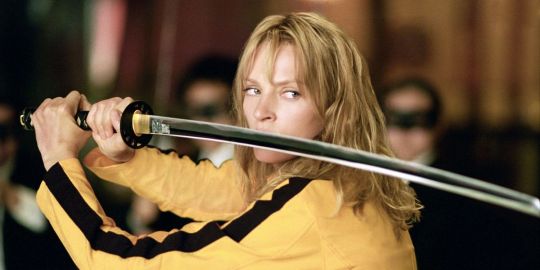
I remember once hearing someone compare Quinten Tarantino films to Frank Ocean songs, and while that comparison might not ring as significant to the average person, when I first heard it, I immediately understood. Both Tarantino and Frank have a way of storytelling that is gripping and engaging, but also hard to pull off; they give information in small bits at a time, only filling in the blanks when it’s necessary for the audience to know something in order to convey a bigger picture. I kept this in the back of my mind as I watched the “Kill Bill” series for the millionth time and realized that the statement still held up. Tarantino’s style of directing and writing (which is arguably its most distinguished in the two films) is sporadic in a way that leaves the audience on the edge of their seat – always eager to get to the next chapter of the story. Not only that, but the dramatic script, creative fight choreography, and amazing performances by the cast all come together to create one of the most iconic viewing experiences of the century thus far. Because the series comprises two films, I’ll be reviewing them as one just for the sake of time, even though both films have their own distinct qualities and characteristics.
The story of “Kill Bill” follows a young woman who formerly belonged to a deadly assassination squad as she travels across the world seeking revenge for the murder of her family and friends at the hands of her former comrades. The Bride, played by Uma Thurman, slowly makes her way through each of the other five members of her former group before she ends up facing off with the titular Bill character, played by David Carradine.
Starting off with the script, while the premise itself isn’t all that creative, the execution is what makes it stand out the most from other action films of the early 2000s. The films borrow many tropes and plot points that are reminiscent of both old kung fu flicks and westerns, and I’d say the way in which the script stands out the most is how characters drop one-liners reminiscent of said older films. There are so many banger lines in these films I can’t even begin to count them all. A personal favorite of mine comes from the first film where Hattori Hanzo (played by Sonny Chiba) is presenting a blade to Beatrix and proclaims, “If on your journey, you should encounter God, God will be cut,” obviously in reference to the blade being his best work. The films are filled with lines such as these, and while they’re very over the top and dramatic, within the context of the film coupled with Tarentino’s directing style, they fit perfectly.
Not only that, but as I stated before, many of the scenes and characters' backstories also pull from very common tropes seen in kung fu, western, and anime films. A prime example of this would be the entire training montage between Beatrix and her master Pai Mei, played by Gordon Liu. In said montage, Beatrix is shown perfecting multiple different styles of kung-fu as well as undergoing training exercises commonly featured in older kung-fu movies such as carrying buckets of water up and down flights stairs. It’s also important to note that Gordon Liu is also a famous martial arts actor in his own right, having starred in iconic films such as The 36th Chamber of Shaolin and Shaolin and Wu Tang.
I think another great example of Tarantino implementing an anime style of storytelling into his works is the entire chapter of the film dedicated to O-ren Ishii’s backstory. O-ren, played by Lucy Liu, is a fan favorite, and I think this is in no small part to the extensive amount of time Tarantino spends on building her up as the main antagonist of the first film. O-ren’s backstory is told through the medium of animation, which is fitting given her Japanese heritage, and in said backstory, her parents are brutally murdered at the hands of a yakuza boss. She eventually seeks her revenge, which sends her down the path of becoming an assassin and a crime boss of her own making as well. It's a classic villain origin story. One that is very common in many anime both past and present. Despite this section being the only animated part of the movie, and O-ren being the only villain Tarantino decides to spend such an extensive amount of time focusing on, it never feels out of place and only serves to make the film even more distinctly unique than it already was.
Now, taking a bit of a step away from me glazing Quinten Tarantino, I’d like to draw a bit of attention to the choice of licensed music and the soundtrack. The choice to use Nancy Sinatra’s Bang Bang (My Baby Shot Me Down) as a sort of theme for the film is excellent. It’s the first song that plays and perfectly foreshadows the premise of the movie when the audience has little information about the film. A few other favorite songs of mine featured in the film are The Lonely Shepherd, composed by Gheorghe Zamfir and James Last, and The Flower of Carnage by Meiko Kaji. Each song perfectly fits the tone of the scene it’s featured in, which is a skill that not many directors can easily pull off in this day and age storytelling. I also think it’s very interesting that they brought on RZA to do most of the production for the two films. Considering how Wu-Tang Clan based a good majority of its act on the same kung-fu films that Tarantino was trying to emulate, the choice to bring him on was a spectacular one.
And finally, with the acting, I can confidently say that there isn’t a single bad performance in the movies. Even though I did say that I think the dramatic ass script works because it’s coupled with such a sporadic style of directing, what really pulls it together is the delivery from the cast of characters, both major and minor. Focusing on Uma Thurman, she’s able to portray Beatrix Kiddo in a way that makes her seem like a far cry from the stereotypical, “badass” action woman that we’re familiar with seeing nowadays. Don’t get it twisted, she’s still badass, but the way she’s so easily able to portray moments of vulnerability, fear, sorrow, and even joy and snarkiness gives the character so much personality. It makes the film much more enjoyable to watch, and makes Beatrix a much more likable protagonist. One of my personal favorite scenes is the moment when she finally kills Bill at the end of the second film and has a breakdown in a motel bathroom while her daughter is sitting in the other room. It’s unclear whether or not she’s crying out of relief or sorrow, but the fact that the scene is up to much interpretation without leaving the audience completely in the dark is a testament to how well Uma Thurman played the character.
And finally, the directing itself. As I mentioned earlier, Quinten Tarantino has a style of directing that fills in the blanks rather uniquely. Instead of telling the story chronologically, he starts the film in medias res and places backstories and random bits of information wherever he deems fit. While that sounds like a recipe for disaster, it doesn’t seem to take the audience out of the experience, not one bit. If anything, I think it prevents the story from becoming one note and stale. One thing I also think he does well is setting up ideas and having them pay off well in later scenes. Probably one of my favorite payoffs in the film comes from the flashback of Bill talking to Beatrix about Pai Mei. He tells her the story about how Pai Mei killed a monk by using a move called the Five-Point-Palm Exploding-Heart Technique. It is the same move that Beatrix uses later on in the film to actually kill Bill.
There isn’t enough time in the world to truly go in depth about how amazing these films are and how intricate the storytelling is. I think I am a bit biased because on top of me loving so many qualities about these films, I remember my dad introducing me to these movies and while watching them, I could only think about him. But, even outside of my own personal bias, there’s no doubt that all the qualities I listed above are what helped it become one of the iconic action series of all time. It’s inspired so many films and TV shows since then and will undoubtedly continue to remain relevant in the eye of pop culture for many years to come.
Works Cited:
Kill Bill Vol. 1, Dir. Quinten Tarantino, Miramax, 2003.
Kill Bill Vol. 2, Quinten Tarantino, Miramax, 2004.
2 notes
·
View notes
Text
Discover the World of Resin Art Classes in Jaipur with Core Creator
Art and craft enthusiasts in Jaipur have a new avenue to explore their creativity with resin art, a medium that combines color, texture, and shine into stunning, unique creations. Core Creator, a leading name in art and craft education, offers specialized resin art classes in Jaipur that cater to beginners and seasoned artists alike. Whether you want to pursue a hobby or develop a professional skill, these classes are designed to inspire and empower your artistic journey.
What is Resin Art?
Resin art involves using epoxy resin to create mesmerizing works of art. This medium offers versatility, allowing you to design anything from vibrant abstract paintings to functional items like coasters, trays, and jewelry. Resin art is celebrated for its glossy finish, durability, and ability to incorporate various materials like pigments, glitters, and even dried flowers.
Why Choose Resin Art Classes at Core Creator in Jaipur?
Expert Instructors At Core Creator, you will be learning from experienced and skilled instructors who have a deep understanding of resin art techniques. These experts guide you through every step of the process, from the basics of mixing resin to advanced techniques like adding pigments, creating custom molds, and mastering different textures and effects. With their guidance, you will gain the confidence to experiment with your artistic creations and develop your own style.
Comprehensive Learning Experience Core Creator's resin art classes are designed to cater to all levels of learners. If you're a beginner, the class will start with the fundamentals of resin art, including materials, safety precautions, and basic mixing techniques. As you advance, you will be introduced to more complex techniques such as creating 3D effects, embedding objects in resin, and working with multiple layers. The classes are structured in a way that ensures you learn at your own pace, making the experience both enjoyable and educational.
Hands-on Training One of the standout features of Core Creator's resin art classes is the emphasis on hands-on training. Unlike many other art classes where you only learn theory, here you get to dive right in and create your own pieces. The instructors guide you as you work on your projects, helping you refine your skills and explore different resin art styles. Whether you're making your first resin coaster or creating a stunning resin painting, you'll gain valuable experience by working on actual projects during the classes.
Personalized Attention At Core Creator, every student matters. With small class sizes, instructors can provide personalized attention to each student, ensuring that everyone gets the support they need to succeed. Whether you need help with a specific technique or have questions about your project, the instructors are always ready to assist. This individualized approach helps students grow more confidently and comfortably in their artistic abilities.
Creative Freedom Resin art is all about personal expression, and at Core Creator, you are encouraged to push your boundaries and explore your creativity. During the classes, you will have the freedom to experiment with different colors, textures, and shapes to create pieces that are uniquely yours. Whether you're interested in making functional pieces like trays or coasters or want to create stunning decorative items, you'll find that the possibilities are endless.
Quality Materials Core Creator ensures that all the materials provided for resin art classes are of the highest quality. From premium epoxy resins to vibrant pigments and molds, everything you need for your resin art projects is included. Using top-tier materials ensures that your creations will have a professional, glossy finish and last for years to come.
Interactive Community Joining Core Creator’s resin art classes also means becoming part of a supportive and interactive community. The classes allow you to connect with like-minded individuals who share your passion for art. Whether you're discussing new ideas, sharing your creations, or seeking feedback, the community at Core Creator is welcoming and encouraging, making it a great place to build connections and friendships with fellow art enthusiasts.
Access to Future Workshops and Events Once you enroll in Core Creator's resin art classes, you gain access to future workshops, exhibitions, and events. Whether it's an advanced workshop focusing on intricate techniques or an exhibition where students showcase their work, these opportunities provide a platform for you to grow as an artist. It’s not just about learning; it’s also about connecting with the art world and expanding your skills continuously.
Conclusion
If you’ve ever been curious about resin art or want to develop your artistic skills, Core Creator’s resin art classes in Jaipur offer a fantastic opportunity. Whether you want to create functional art pieces or decorative showstoppers, the classes provide you with all the knowledge and skills you need to unlock your creative potential. Join Core Creator today, and embark on a vibrant artistic journey that will leave you inspired and amazed at your own creations! Contact us today for more details.
0 notes
Text
How to Become a Professional Artist
I still remember my first sale. It was at one of my very first shows and I recall feeling shocked at the idea that someone was willing to pay money to own my painting! I immediately called my mother (an artist herself) and remember her saying, “Now you’re officially a professional!” In that moment I felt like a professional, but perhaps it’s not quite that simple.
That was the definition my mother was given as she was learning. Since then, I’ve learned that the road to truly being considered a professional artist is actually a little more complicated. I’m sure there are many different perspectives on this, but following is what I’ve experienced and what I feel is a fairly typical step-by-step process.
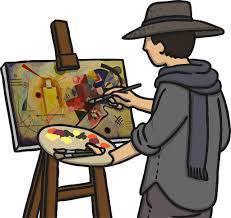
1. Hone Your Skills
The first and most important step in becoming a professional artist is to develop your skills. Build up your knowledge and brush handling capabilities by taking classes, studying expert work, and practicing. If you want to be a professional, you need to get your work to a level where it can hold its own among all the other artists. It’s a tricky thing to define. It’s a lot like the difference between a brand new cake decorator and one with years of experience and training. The difference in skill level is visual.
2. Test Your Work
Once you feel your work is of a high enough caliber, test it. See if your work is ready by entering your strongest piece in a local art show. Watch the audience as they view it. One thing I like to do (even today) is take off my artist badge and browse around near my work so I can overhear and observe viewer reaction. Did your piece sell? That’s also a very good sign.
You can also ask for feedback from the people around you who aren’t afraid to speak the truth but are also not chronically critical. Or, you can observe people who are exposed to your work but have no personal connection, such as the person who assists you when you get a piece framed. Do they seem genuinely impressed with your painting? Take note, but also remember that everyone has different tastes. Try to get multiple opinions.
3. Discover What You’re Good At
Where do you excel? I initially wanted to paint florals, but after many frustrating attempts and almost giving up on painting entirely, I finally decided to try a portrait. After all, I used to sketch people all the time as a young girl and I wasn’t too bad. As it turned out, portrait painting came much easier! It seemed to match the way I think. Look for your area of strength, and that can relate to subject matter, painting medium, or painting style. If one way isn’t feeling natural, try another.
4. Develop a Body of Work
Develop a solid base of ten to fourteen pieces that you feel confident in. They should be cohesive and of a high skill level. Typically, you want each piece to relay a consistent painting style and similar subject matter, if possible.

5. Learn How to Photograph Artwork
This isn’t quite as simple as it sounds. You need to make sure the photographs you produce are of a high quality because they are going to represent your work. 1. There shouldn’t be any blur (so consider using a tripod), and the lighting should be even. 2. Many experts recommend photographing outside on a temperate, bright but overcast day. This creates a kind of natural white box. Mid-day offers the most neutral color tone as well, so perhaps aim to photograph somewhere between 11am-2pm. 3. Your primary image should show the painting image only - not the mat, frame, wall, or any other surrounding material. These items can simply be cropped out using a photo manipulation software.
6. Create a Basic Website
Using that well-photographed initial body of work, create a simple but professional website. Websites are the portfolio of yesterday. If you want to be competitive, you need to be online in my opinion. At this point, the site can be relatively simple, to include your name, a little bit about you, your work, and contact information. You can create a simple site using a website building template such as wix.com, weebly.com, or SquareSpace.com. Many sites offer free versions with a basic template. That’s okay to start with, but eventually you will need to upgrade. While you're at it, you should consider creating a presense on select social media formats. Keep it simple - select a handful that appeal to you and set up an account.
7. Start an Artwork Database
This is also the time to establish a computer database to track your work and exhibitions. Do this early in your career so you don’t loose track. I, personally, like Artwork Archive, but you can begin with a program you already have on your computer or search online for other alternatives. If you want to be a serious artist, it really helps to keep things organized and the earlier the better.
8. Build Your Resume
With a solid initial body of work established, quality photographs taken of your work, a basic website ready to go, and a method to track your career, it’s now time to develop your resume. This means entering local shows, joining local art groups (and participating in their group exhibits), and/or perhaps working with local small venues such as a coffee shop or library that features local art. It’s time to get your work out in public.
9. Expand Your Marketing Efforts
An artist statement is basically what you want to say with your work, what makes it unique, or what you want the viewer to experience when seeing your work. A bio is simply your artist history (education, exhibits, etc.). All of this needs to be added to your website (if it’s not already there), and your website will need upgrading to one that allows you to use your own domain name. A domain name is the website address name (such as JaneDoeArt.com). Most free websites require you to use an extension in your address such as JaneDoe.weebly.com. It’s best to present yourself clear of any such extensions, so seriously consider purchasing one with only the name you decide upon. Artists often just use their name, such as janedoe.com, but it’s totally up to you. Just make it easy to remember.
You should also now have an idea of pricing and will need to maintain consistency in that regard. Price increases should come slowly or after a special honor or professional association. And business cards are still used today to let people know your website address, where they can see more of your work or contact you.
youtube
10. Increase the Quality of Venue and Group
As you continue to grow your experience, both in exhibiting and painting, you should hopefully start to see growth in your skill level as well. If you find you’re receiving praise for your work or even winning local awards, you may want to start looking into higher-end exhibits and art associations. Perhaps try entering your best piece in a national show or seek out a solo exhibit at a reputable venue. Go beyond what is local.
11. Always Present Yourself as a Professional
Being a professional is more than just meeting certain goals, in my opinion. It’s also how you present yourself. It’s how you carry yourself, the way you dress, and the confidence you show in your work. When you engage in the art world, dress well, look clean, present your work in the best light…and have professional looking marketing materials. You wouldn’t believe the negative impact an unkempt mat and frame can have, for example. Or on the opposite tack, the positive one that a smartly dressed, engaging persona can have.
12. Decide What Direction You Want To Go In
Now that you’ve reached a professional level in your work, have a solid resume, and professional marketing materials you need to decide how you want to focus. There are many paths you can take as a professional artist. It’s impossible to do everything or every angle, so I would suggest picking two or three paths and focus your efforts on them. The paths I’m referring to are:
Exhibitions and involvement in the arts community
Gallery representation
Outdoor art markets
National and international art fairs
Teaching
Plein air competitions
Commission work
As you attend certain events, chat with the artists there and get a feel for how that career path impacts their life. Plein air competitions, for example, will involve travel. Commission work will require contracts and ways to communicate with clients. Outdoor markets will mean travel and the need to purchase a proper tent and hanging materials. Observe and ask questions. You’ll find that some appeal to you more than others.
There are many paths to becoming a professional artist because every artist (…every person) is unique. But you can use this information as a general template to help you get going in the right direction and discover your individual track.
1 note
·
View note
Text
Enhance Your Creativity with Wacom Artwork Tools
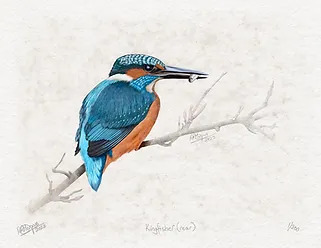
In the world of digital artistry, having the right tools is essential to bringing your ideas to life. Whether you're an aspiring artist or a seasoned professional, Wacom artwork tablets are designed to elevate your creativity to new heights. Known for their precision, responsiveness, and ease of use, Wacom tablets have become a staple for those creating stunning digital pieces, from sketches to detailed illustrations. In the artwork industry, especially in the UK, digital tools like Wacom help bridge the gap between traditional methods and modern technology.
Why Wacom Artwork Tablets Are Popular Among Artists
Wacom tablets provide an intuitive, pressure-sensitive surface that mimics the experience of drawing on paper. Whether you are working on graphic design, illustrations, or even complex computer artwork, these devices offer a natural feel with precision that traditional methods can't always achieve. With adjustable settings and a range of pen nibs, you can create detailed and professional-level artwork in various styles.
Advantages of Using Wacom for Computer Artwork
High Precision: Wacom tablets are known for their incredible sensitivity, allowing artists to make fine adjustments with ease. This makes it perfect for complex computer artwork that requires attention to detail, like concept art, character design, and animation.
Versatile Software Compatibility: Wacom devices work seamlessly with popular design software like Adobe Photoshop, Illustrator, and CorelDRAW. Whether you're creating in 2D or 3D, Wacom provides a smooth experience that integrates with your creative process.
Customizable Settings: Wacom tablets allow artists to personalize their experience by adjusting pressure sensitivity, shortcuts, and pen responsiveness. This means you can tailor your tablet to suit your workflow, whether you're creating sketches or detailed digital paintings.
Ergonomic Design: Drawing for hours can be tiring, but Wacom tablets are designed to be comfortable for extended use. Their lightweight pens and responsive surfaces reduce strain, helping you stay focused on your artwork.
Wacom Artwork in the UK: A Growing Market
The demand for high-quality artwork tools in the UK has been steadily increasing as more artists, illustrators, and designers transition to digital platforms. Whether you're a freelancer, part of a creative agency, or a hobbyist, Wacom products are widely available across the UK. These tablets have gained popularity because they help artists create artwork that matches the quality of traditional mediums while offering the flexibility and speed of digital creation.
Where to Find Wacom Tablets and Accessories in the UK
Finding Wacom products in the UK is simple, with a wide range of online and physical retailers offering the latest models. You can easily purchase Wacom tablets from major electronics stores, art supply shops, or online platforms like Amazon and official Wacom resellers. Additionally, many local distributors offer support, training, and warranties for these devices, ensuring you get the most out of your investment.
The Role of Digital Tools in Modern Artwork
Digital technology has reshaped how artwork is created, shared, and appreciated. Computer artwork has grown in popularity across various industries, including advertising, gaming, animation, and fine arts. Whether it's creating visually stunning posters, designing logos, or producing concept art for films and video games, digital tools like Wacom make it easier than ever to produce high-quality results quickly and efficiently.
Using Wacom tablets, artists can also experiment with different brushes, textures, and effects that would take much longer to achieve with traditional mediums. The ability to undo mistakes, make layers, and adjust fine details with precision means artists can push their creative boundaries and create artwork that is both innovative and polished.
Conclusion
Wacom artwork UK tools have revolutionized the way artists create digital pieces, offering a perfect blend of precision, versatility, and ease of use. For artists in the UK and beyond, these devices provide a reliable platform to express creativity, whether you're working on computer artwork, illustrations, or fine art pieces. If you're ready to take your artwork to the next level, investing in a Wacom tablet could be the game-changer your creative process needs.
0 notes
Text
Video Ideas
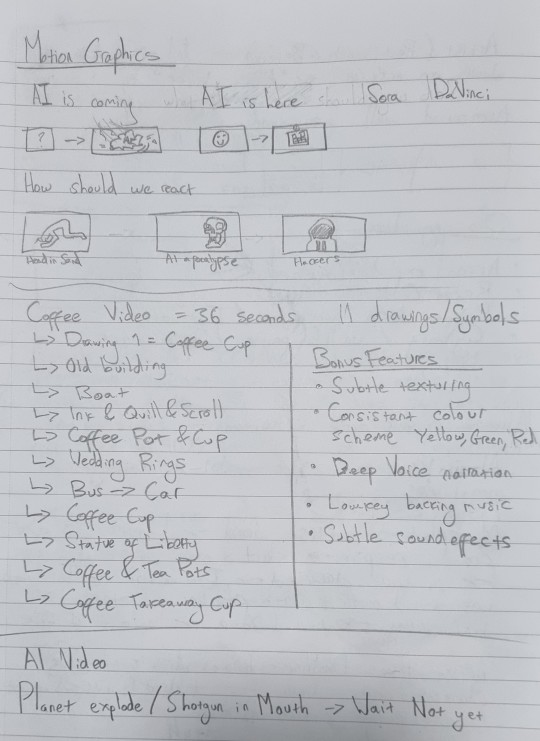
youtube
With the coffee video above as a point of reference for this project, I scribbled out a couple of visual ideas about this project. Then to get a better understanding of what I liked about the coffee visuals, I briefly analysed the progression of the video some the stylisation to each drawing which acts as visual entertainment and symbolic/literal representations of what is being discussed. I need my own symbols to be a little more abstract as that is the nature of this module, I want to experiment and explore shape and iconography and play around with repetition, shapes and transitions to get a short punchy video about AI. I need to keep things simple with enough room to play around until I can find a happy medium between practicality and creativity so that I end up with a finished product that I like.
Kurzgesagt is another channel with engaging colourful visuals and I will draw inspiration from the harmony between the bright animation and the calm curious voice-over. I don't have access to voice-overs myself so I could try it myself, find a friend or use AI, I haven't decided yet as whatever I decide upon can play into the tone of the video - silly VS serious or both.

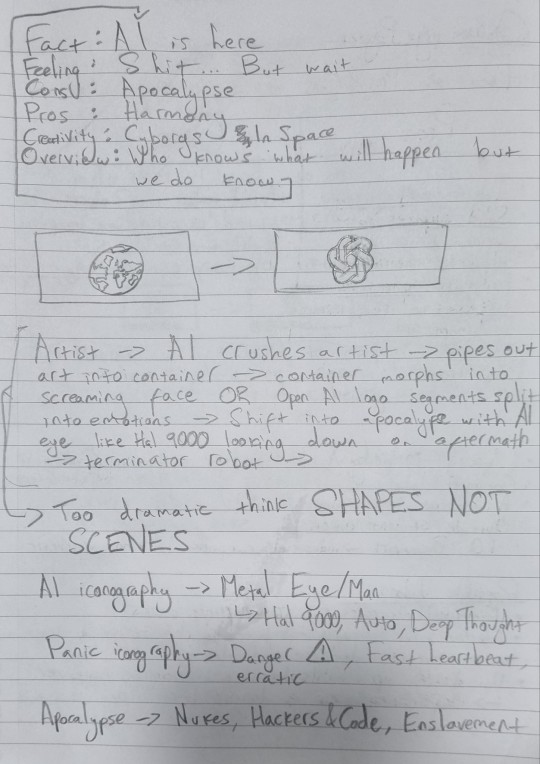
Some more ideas I was playing around with, I was taking a bit too many notes and started leaning into narrative too much and which takes away from the abstract visuals that are the core premise of this project. I need to find fun trippy methods to transition between each visual subject guided by the narration and sound effects to explore the topic of AI either from my own perspective or that of the artist or an average Joe.
youtube
I am aiming for a light-hearted somewhat informative style of video so I want to replicate in some ways the TV static and old fashioned radio voice in training videos from decades ago. The video above is a satire of the same style of video focused around surviving in the apocalypse with a little character guided by a narrator. Again, I don't want a character to be the focus and instead want to maintain a fluidity of motion all of which is guided by sound and music.
youtube
youtube

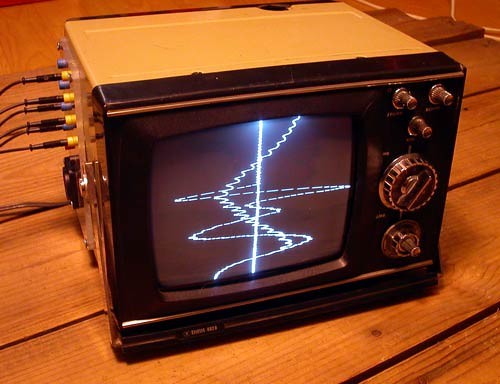
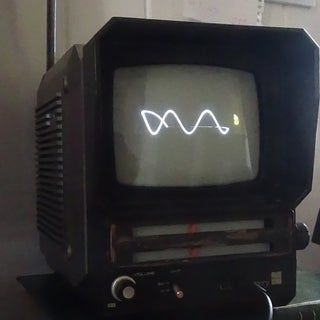

For the projection side of things, I need to figure out a way to give it that vintage educational video aesthetic so once I have animated a clean version of the video, I will need to rough it up with TV static, grain etc... I want to go for an old cathode ray tube style or as if it was made using film to give it a more interesting visual aesthetic. I may use some of the tutorials above but I have not looked deeply into this side of things yet however I do know that I will need to try and build my own old fashioned TV out of cardboard or find an old cheap TV that I could play it on.
youtube
For this project I am aiming to make something that incorporates stylistic elements from similar videos to the one above and also the motion graphics feel of the coffee video.
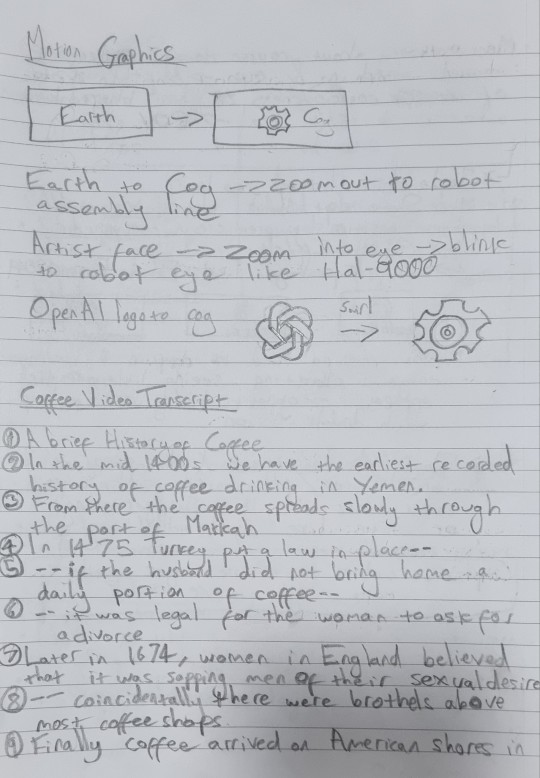
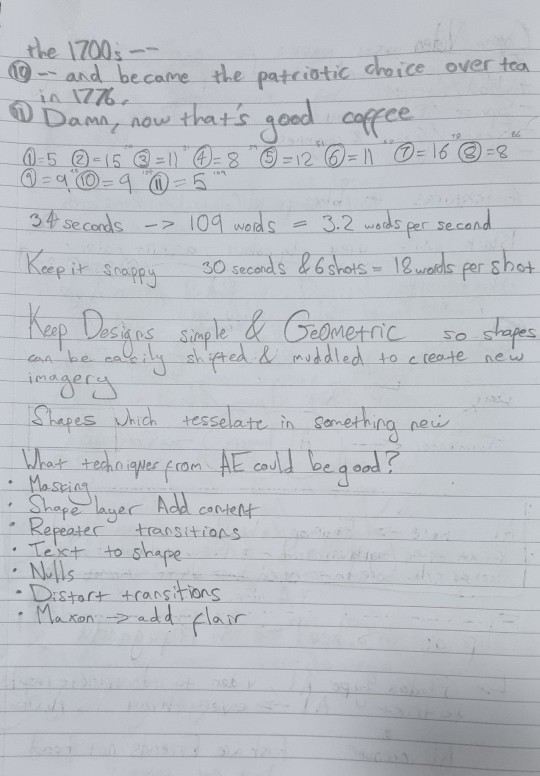
I started thinking about the limitations of the project because that is where I have messed up in the past; there is only a small window of time for me to make this animation and the duration cuts short any detailed expansion. Topics need to be covered in brief aided by visuals fast paced dialogue and visuals. Just to get a judgement of the depth of my dialogue, I counted the words in the coffee video which came to 109 words in 34 seconds; concise narration is crucial if I am adding narration.




There's a lot of similarity between these shapes for simple transitions of key topics of this video:
Robotics = Cog
AI = OpenAI logo
Earth & Humanity = Globe
Digital Humanity = Digital Globe
Whilst searching for that iconography I found out about The Noun Project which has 5,000,000 icons for different topics which could be essential building blocks that I can expand upon when trying to represent complex themes with simple geometry.
0 notes
Text
Artist Research - Ana Mendieta
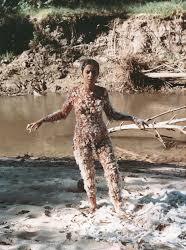

1948 - 1985
Cuban - born in Havana
Died in New York, USA
Was a pioneer of the earth art/land art movement of the ‘60s and ‘70s that rose in response to the growing commercialisation of art.
She did work in photography, film, video, drawing, sculpture, and site-specific installations.
The major themes in her work are exile, displacement, and a return to the landscape.
“My art is the way I reestablish the bonds that unite me to the Universe. It is a return to the maternal source.”
Throughout her career, Mendieta’s explorations of representation were grounded in an intersectional conception of identity where race, gender, age, and class operated simultaneously. “As non-white women, our struggles are two-fold,” Mendieta wrote in a curatorial statement for an exhibition of women artists of colour. “This exhibition points not necessarily to the injustice or incapacity of a society that has not been willing to include us, but more towards a personal will to continue being ‘other.’”
She also explored multiple layers of meaning ascribed to blood—from death to rebirth. This is seen from her Body Tracks series as well as her elegant drawings of abstracted outlines of paleolithic goddesses, repeatedly inscribed on a variety of surfaces, from modern paper to an actual leaf to an ancient style of bark cloth.
Biography:
She was born in Cuba in 1948 — the time of the Cuban revolution.
She belonged to a wealthy aristocratic family. Her father, Ignacio Mendieta, had worked closely with Fidel Castro until the late 1950s, when Cuba became riddled with conflict, and Castro confirmed his communist ideologies. Ignacio parted ways with Castro, and aligned himself with counterrevolutionary activity.
Mendieta moved to an orphanage in Iowa, USA, at age 12 with her sister as part of a US government asylum program for adolescents after the Cuban revolution (Operation Pedro Pan), due to her parents being targeted by Castro’s new regime.
The understanding was that the parents would be reunited with their children in about a year or two, but Mendieta would not be able to return to Cuba until 20 years later.
The new environment, combined with the racial climate of the 1960s Civil Rights Movement, heightened Ana Mendieta’s awareness of racialised misogyny. as both girls would experience targeted gendered discrimination from their high school classmates in the form of derogatory ethnic terms and sexualization. Mendieta remembers being told, ‘Go back to Cuba, you whore.”
Mendieta eventually enrolled at the University of Iowa and, upon completing her undergraduate degree, began her graduate studies in art. After training as a painter, Mendieta quickly grew dissatisfied with the medium and transitioned to the university’s new MFA in Intermedia program, where she began to develop her interdisciplinary work.
On a class trip to Mexico in 1973, Mendieta visited several pre-Hispanic sites and became interested in Indigenous Central American and Caribbean rituals. This manifested in her work through her exploration of the concept of a goddess figure into her work
Ana met artist Carl Andre through mutual friends in 1979, dating for many years before marrying in January of 1985. Andre was born and raised American. He grew up in Quincy, Massachusetts, attended school at Phillips Academy, and then enlisted in the U.S. Army all before moving to New York City in 1956. Andre would come to make a name for himself in the art world as one of the pioneers of American minimalism sculpture.
In autumn of 1985, less than a year after getting married, Ana fell to her death from their 34th floor apartment window after a night of drinking and arguing, Andre was arrested and charged with second degree murder.
The trial wouldn’t take place until 1988. Unsurprisingly many of those who maintained his innocence were prominent white male artists, gallerists, and collectors who favored protecting patriarchy over bringing light to the injustices and erasure of Ana Mendieta
0 notes
Text
Content Repurposing: Maximizing the Value of Your Content
Creating high-quality content is a cornerstone of successful digital marketing and web design. However, many businesses and web designers underutilize their content by not exploring its full potential. Content repurposing is a strategy that allows you to breathe new life into your existing content, extending its reach and value. At Digital Orix, the leading web design course in Jaipur, we recognize the significance of optimizing your content for maximum impact. In this blog post, we'll delve into the art of content repurposing and how it can enhance your web design career. Additionally, we'll show you how our course can empower you with the skills to excel in web design while making the most of your content.
Why Content Repurposing Matters
Content repurposing offers several advantages:
Efficient Use of Resources: Repurposing content allows you to get more mileage out of the time and effort invested in creating it.
Extended Reach: Different formats and platforms attract diverse audiences, broadening your content's reach.
Improved SEO: Repurposed content can target different keywords, potentially boosting your search engine rankings.
Enhanced Engagement: Varied content formats cater to different learning styles and preferences, engaging a wider audience.
Strategies for Content Repurposing
Here are some effective strategies for repurposing your content:
1. Transform Blog Posts into Visual Content
Turn informative blog posts into engaging infographics or slideshows. Visual content is highly shareable and can captivate your audience.
2. Create Video Tutorials
Repackage written tutorials or how-to guides into video tutorials. Videos are a preferred medium for learning and can enhance your content's accessibility.
3. Compile Ebooks or Guides
Gather related blog posts or articles to create comprehensive ebooks or downloadable guides. This adds value for your audience.
4. Generate Social Media Posts
Extract key points from longer content and create bite-sized social media posts. Use attention-grabbing visuals and quotes to entice engagement.
5. Podcast Episodes
Transcribe your podcasts or webinars into written content. This makes your audio content accessible to a broader audience and improves SEO.
6. Update and Republish
Revise and update older content to ensure its relevance. Republish it with fresh insights and data.
Digital Orix: Your Path to Web Design Excellence
To excel in web design and maximize the impact of your content, enroll in Digital Orix's web design course in Jaipur. Our course provides comprehensive training in web design, empowering you with the skills and knowledge needed to excel in the digital marketing landscape.
What You'll Learn:
Web design principles and best practices
Creating visually stunning and effective websites
Harnessing the power of content repurposing
Practical experience with web design projects
Personalized mentorship and guidance
Why Choose Digital Orix?
Industry-experienced instructors with expertise in web design and content strategy
Hands-on, practical web design projects
Personalized mentorship and guidance
Access to industry-standard web design tools
Career support and placement assistance
Don't let your valuable content go to waste. Contact us today and join Digital Orix's web design course in Jaipur, to gain the skills and knowledge to excel in web design while making the most of your content through effective repurposing.
In conclusion, content repurposing is a valuable strategy for extending the life and impact of your content. With Digital Orix as your guide, you can master this technique to enhance your web design career.

0 notes
Text
Copywriting Training London: Unlocking the Secrets of Professional Writing
Copywriting training in London refers to educational programs, courses, workshops, or seminarsspecifically designed to teach individuals the skills and techniques of effective copywriting.
Copywriting training in London, like what professional firms like Blackad
offers, are tailored programs which aim to equip participants with the knowledge and practical skills necessary to create persuasive and compelling written content for various mediums, such as advertisements, websites, social media, marketing materials, and more.
Is Copywriting Training In London An Effective Way To Learn Copywriting?
Training programs centred on copywriting typically follow a structured curriculum designed to teach you the fundamental principles and techniques of copywriting. Theyprovide a systematic approach to learning, starting from the basics and progressing to more advanced concepts.
Many copywriting training programs include practical exercises and assignments that allow you to apply the concepts and techniques you learn. These hands-on activities allow you to practice your skills, receive feedback, and improve your copywriting abilities.
By working on real-world scenarios, you can gain practical experience and develop a portfolio of work.
Participating in copywriting training programs allows you to connect with individuals also learning the art of copywriting. This peer learning environment can foster collaboration, idea sharing, and constructive feedback.
Does London Copywriting Training Pay Off?
The worth of copywriting training and courses in London, or any other location, depends on your specific goals, background, and level of commitment. Dedicated training can be valuable if you're looking to pursue a career in copywriting or improve your writing abilities.
Attending training programs and courses can provide opportunities to connect with like-minded individuals, industry professionals, and potential clients. Building a network within the copywriting community can lead to collaborations, referrals, and new opportunities.
Reputable training providers usually have experienced instructors who can offer valuable guidance, feedback, and industry insights. Learning from professionals with practical experience in copywriting can accelerate your learning process and provide valuable insights.
Some training programs may include assignments or projects that allow you to build a portfolio of work. A portfolio is essential for demonstrating your skills and attracting potential clients or employers.
Consider the cost of the training program and compare it to the potential benefits it offers. Evaluate whether the skills and knowledge you gain from the training can lead to career advancement or increased income.
What Should You Avoid When Doing Copywriting Training In London?
When undergoing copywriting training in the capital of the UK, it's important to be aware of certain pitfalls and avoid them to ensure you get the most out of your learning experience.
Inadequate Research
Copywriting requires a solid understanding of your target audience, product or service, and the competitive landscape. Avoid rushing through the research phase or relying on assumptions. Take the time to gather accurate and comprehensive information to inform your copywriting efforts.
Lack of Practice
Copywriting is a skill that requires practice to master.It’s ideal not to let the temptation of solely relying on theory or putting your knowledge into practice. Engage in writing exercises, work on real-world projects, and seek feedback to continually refine your copywriting abilities.
Neglecting Feedback
Constructive feedback is invaluable in copywriting training. Avoid dismissing or disregarding feedback from instructors or peers. Embracing feedback is important as its an opportunity for growth and improvement.
Limited Variety of Sources
Copywriting is a diverse field with different styles, industries, and target audiences. It’s important not to confine yourself to a single source or approach. Seek out diverse examples, case studies, and industry insights to broaden your perspective and develop versatility in your copywriting.
By being mindful of and avoiding these pitfalls, you can make the most of your copywriting training in London and maximise your learning outcomes. Remember, copywriting is a skill that requirespractice, ongoing learning, and a commitment to improvement.
Final Thoughts
Copywriting training in London can be delivered through various formats, and it's important to research and chooses reputable training providers that offer comprehensive and industry-relevant content.
With copywriting programs in London, like Blackad, you can build a network within the community that can lead to collaborations, referrals, and new opportunities over time.
Source URL By : https://bit.ly/3X8qh1j
0 notes
Text

Overview
The Bachelor of Fine Arts (BFA) course at the Institute of Technology and Management (ITM) is a four-year undergraduate program aimed at providing students with a comprehensive education in the field of fine arts. The course is designed to develop the artistic and creative skills of students while also equipping them with practical knowledge and technical expertise.
The BFA course at ITM covers a wide range of subjects related to fine arts, including painting, sculpture, printmaking, photography, graphic design, and multimedia. The curriculum is designed to provide students with a strong foundation in the principles and techniques of art, as well as an understanding of the historical and cultural context of art.
Throughout the course, students are encouraged to explore their own creative potential and develop their own artistic style. They are also given the opportunity to work on real-world projects and collaborate with other artists and designers.
The BFA course at ITM is taught by experienced faculty members who are themselves practicing artists and designers. They provide students with individual attention and guidance, helping them to develop their skills and reach their full potential.
Upon completion of the BFA course at ITM, students are equipped with the knowledge, skills, and experience necessary to succeed in a wide range of careers in the arts, including as fine artists,illustrators, graphic designers, photographers, art directors, and more. They may also choose to pursue further education in the field of fine arts by enrolling in a Master of Fine Arts (MFA) program.
Why You Should Pursue Bachelor of Fine Arts Course
There are many compelling reasons to pursue a Bachelor of Fine Arts (BFA) degree. Here are just a few:
Develop your artistic skills: A BFA program will provide you with intensive training in your chosen artistic discipline. Whether you're interested in painting, sculpture, photography, graphic design, or any other medium, you'll have the opportunity to hone your skills and become a master of your craft.
Gain a deep understanding of art history and theory: A BFA program will also provide you with a comprehensive understanding of the history and theory of your chosen artistic discipline. You'll learn about the great artists of the past and how their work has influenced contemporary art. You'll also learn about the different artistic movements and styles that have emerged over the years.
Build a strong portfolio: A BFA program will give you the opportunity to create a portfolio of your best work. This portfolio can be used to showcase your talent to potential employers or graduate schools.
Network with other artists: A BFA program will also give you the opportunity to network with other artists and industry professionals. This can be invaluable when it comes to finding job opportunities, collaborating on projects, or getting feedback on your work.
Prepare for a career in the arts: Finally, a BFA degree can prepare you for a career in the arts. Whether you're interested in becoming a professional artist, a graphic designer, an art teacher, or something else entirely, a BFA degree will give you the skills and knowledge you need to succeed.
Overall, pursuing a Bachelor of Fine Arts degree can be a great way to develop your artistic skills, gain a deep understanding of art history and theory, build a strong portfolio, network with other artists, and prepare for a career in the arts.
Career Scope and Job Profiles
The career scope for graduates with a Bachelor of Fine Arts degree is diverse and can vary depending on the specific discipline studied. Here are some examples of job profiles in different areas of fine arts:
Visual Artist: A visual artist creates original works of art, such as paintings, sculptures, and installations. They can work in a variety of settings, such as art galleries, museums, or as independent artists.
Graphic Designer: A graphic designer creates visual concepts to communicate ideas that inspire, inform, or captivate consumers. They work with a variety of mediums, including digital media, print, and advertising.
Art Director: An art director is responsible for creating the visual style of a product or project. They work with designers, photographers, and other creative professionals to ensure that the project meets its objectives.
Animator: An animator creates visual effects and animations for films, television shows, video games, and other media. They use a variety of techniques, including 2D and 3D animation, to bring characters and scenes to life.
Photographer: A photographer captures images using cameras and other photographic equipment. They can specialize in a particular type of photography, such as portraiture, landscape, or commercial photography.
Art Teacher: An art teacher teaches students of all ages about different art forms and techniques. They work in schools, community centers, and other educational settings.
Museum Curator: A museum curator manages collections of art and artifacts in museums and other cultural institutions. They are responsible for acquiring new pieces, preserving existing works, and developing exhibits.
These are just a few examples of the many job profiles available to graduates with a Bachelor of Fine Arts degree. Other career paths include art therapy, fashion design, interior design, and many more. The key is to identify your interests and strengths and find a career path that aligns with them.
Bachelor of Fine Arts Course Required Skillset
To succeed in a Bachelor of Fine Arts (BFA) program, students should possess a range of skills and qualities. Here are some of the essential skills and qualities required for a BFA course:
Creativity: This is perhaps the most important quality for any student pursuing a BFA degree. Creativity is the ability to come up with original ideas and to think outside the box.
Artistic ability: BFA students should have a natural talent and passion for the arts, as well as a strong desire to develop their skills in a specific artistic discipline.
Attention to detail: In fine arts, even small details can make a big difference in the overall impact of a work of art. Therefore, BFA students should have a keen eye for detail and be able to pay close attention to every aspect of their work.
Time management: BFA programs can be intensive, with many projects and assignments to complete. Therefore, students should be able to manage their time effectively and meet deadlines.
Communication skills: Many artistic disciplines require collaboration and communication with other artists, clients, or industry professionals. Therefore, students should have strong communication skills, both verbal and written.
Problem-solving skills: BFA students should be able to think creatively and come up with solutions to challenges they encounter in their work.
Computer skills: In today's digital age, many artistic disciplines require proficiency in digital tools and software. Therefore, BFA students should have a basic understanding of computer applications and digital technology.
Openness to critique: BFA students should be open to receiving feedback on their work, as this is an essential part of the learning process in fine arts.
Overall, students pursuing a Bachelor of Fine Arts degree should have a combination of natural talent, creativity, and technical skills, as well as a strong work ethic and dedication to their craft.
Bachelor of Fine Arts Course Specialisations
Bachelor of Fine Arts (BFA) is an undergraduate degree program that is designed to provide students with a strong foundation in the visual and performing arts. BFA course specializations may vary depending on the university, but some of the common specializations are:
Painting: This specialization focuses on the study of various painting techniques and mediums such as oil, watercolor, acrylic, and mixed media.
Sculpture: This specialization involves the study of various sculpting techniques and materials such as clay, metal, wood, and stone.
Printmaking: This specialization focuses on the study of printmaking techniques such as etching, lithography, screen printing, and relief printing.
Photography: This specialization involves the study of digital and traditional photography techniques, including lighting, composition, and image editing.
Graphic Design: This specialization focuses on the study of graphic design principles and software such as Adobe Photoshop, Illustrator, and InDesign.
Illustration: This specialization involves the study of various illustration techniques and mediums, including digital and traditional drawing.
Film and Video: This specialization focuses on the study of film and video production techniques, including screenwriting, directing, cinematography, and editing.
Performing Arts: This specialization includes theater, dance, and music, and focuses on the study of various techniques and styles within each discipline.
It's important to note that the availability of these specializations may vary depending on the university, and some universities may offer additional or different specializations.
#Bachelor of Fine Arts College In Dehradun#Best Bachelor of Fine Arts College In Dehradun#Top Bachelor of Fine Arts College In Dehradun#Top 10 Bachelor of Fine Arts College In Dehradun
0 notes
Text
i've been thinking a lot about why Disco Elysium in particular has touched the core of my being in a way no other piece of media has and i think there are several factors at play here. this is half a review and half me dumping my various thoughts on this game ever since i finished it a couple months ago.
AS A VIDEO GAME ITSELF—i've been trying to identify what exactly it is about certain games that causes them to rise above all the rest that i've played, and i have come to the realization that in all of them, combat is usually one of the least consequential things on that list. i love Hades, have dumped 160+ hrs into it, but despite it being a very combat-heavy game with extremely tight controls that i do find truly satisfying, that is not what kept me playing. it's the characters, the art, the story, the world-building, the music...
similarly, while the combat in Horizon Zero Dawn is really quite fun, what really charmed me about it was its spunky, badass protagonist and fascinating mechanical creature designs, in addition to the story set in a world that captivated me from beginning to end. Night in the Woods took my breath away with its emotional & poignant writing told through a unique & delightful art style. i didn't even finish The Last of Us, but Ellie's moment with the giraffes is ingrained in my brain—and of course i went ahead and watched someone else play through to the end so i could enjoy the rest of the story without having to slog through zombie fights myself. so while i always appreciate well-executed combat in games (and have given up on games that do it too poorly), it's never what keeps my interest.
SO. what happens when you take combat out of a game entirely, and absolutely excel at everything else? you see where this is going.
THE CHOICE OF MEDIUM—the fact that DE's story was told through a video game (as opposed to a book, a show, a movie, etc.) is absolutely crucial, because of your active role in the consumption of said story. i think that's what gives some of its scenes such devastating emotional impact. watching this train wreck of a character that you happen to be playing blurt out the most unhinged responses despite your best attempt to salvage the situation, coming to terms with the awful reality of what's in front of you at the same time Harry does, seeing the immediate results of your choices as well as slowly realizing how your choices affect the story long-term as the pieces start coming together... all of this creates an immersive experience that is unparalleled. the game doesn't take self-insert so seriously that the protagonist ~can be anyone~ (Harry's characterization is, in fact, very strong and well-established) but there's absolutely no way a Disco Elysium book or show would have the same impact as me having to progress the story by fucking around and finding out.
GAME SPOILERS AHEAD—combining these two aspects of DE helps to explain what made the tribunal the MOST TENSE i've ever felt playing a video game. this is essentially as close to combat as you'll get in this game. you've just spent the last 20-30 hours becoming very familiar with the mechanics of the game with regards to the dice rolls. you become accustomed to the fact that most skill checks are white so you can come back to them, and that red checks are comparatively rare. enter the tribunal: suddenly you have several very high stakes red checks in a row. you can't leave. you can't try an individual check again if you fail. the story itself has been alluding to this very moment throughout the game. people are DYING, and the lives of those that remain, including your own, are on the line. your earlier decisions have come to a head.
it was 3 am when i got to this point in the game, and the reality of the situation i found myself in shook off every bit of sleepiness i'd been feeling up to this point—my eyes were wide open and my heart was pounding.
i know many people who play video games derive a lot of satisfaction from perfecting mechanics, learning patterns, or deducing the weaknesses of a difficult boss. for me, this satisfaction gets dwarfed by the frustration of having to spend far too long dealing with it in the first place. triggering a boss battle oddly takes me out of the story, because it feels like a very marked switch from "being the protagonist in the game's world" to "sitting on my couch playing a Video Game", where the same repetitive action of "killing the enemy" becomes my goal, no matter what the game is.
by contrast, the tribunal was very much a continuation of the story with each skill check having immediate results on how that story plays out. no other moment in the game was quite like it, and i had no idea how this sequence of events was going to go, so every action felt extremely fraught. i was on the edge of my seat in a way no other game has gotten me to feel, because the weight of this encounter felt monumental in DE. and of course, this is where you come across an iconic skill check where you find out exactly how much your previous choices matter...

i was so damn nervous during this check i probably would've cried if i failed it lmao
FUCK YOUR EXPECTATIONS—this leads me to the other thing that's got me smitten with this game: the subversion of expectations. dialogue options are never written so transparently as to have a "correct" answer, and trying to stay neutral with my answers got me a well-deserved smack in the head in the form of a brutal burn about the dangers of centrism. we have 3-dimensional characters that make you growl in frustration one moment and your heart swell in the next, descriptions that make you marvel at both the beauty and ugliness of humanity, situations where you feel crushed by sadness and dread then want to cry tears of happiness because despite all of it, there is still magic left in the world. it's also so goddamn funny. this game is fucking hilarious—and what is comedy, what is a punch line but the subversion of an audience's expectations established during the setup?
Disco Elysium is a game that far exceeds the sum of its parts. it excels in its storytelling, its voice acting brings incredible life to said phenomenal writing, its gorgeous painterly art style is visually compelling, its music is flawlessly incorporated to full effect, it's intellectually stimulating and fascinating philosophically, and as a murder mystery (oh yeah that's what this game's premise is, right?) it's just plain fun to reveal clue after clue while pondering theories as to what the heck is going on. these individual components come together to create a multi-dimensional piece of media that's deeply human, yet fantastical and absurd. it's uncomfortably relatable while inspiring empathy for even the most unfamiliar of experiences.
for instance, i have no personal experience with alcoholism or addiction, but boy do i sure know what it's like to have a compulsion to apologize at every opportunity for simply existing—to want to cease existing, period. i don't know what it's like to grow up and live in a post-soviet country yet the experience in-game felt as vivid as ever, inextricable from the story's identity. i felt a pang of pained recognition in Kim's complicated relationship with his race as diaspora, and found myself wishing i had the ability to respond even half as effectively as he did with the Racist Lorry Driver during my own past run-ins with racist assholes. this game has caused me to think more deeply about my own politics, my relationships, the world around me, the power of art, the role of capitalism, beauty, hope... even what it means to be alive.

A CHANGED PERSON—a realization i came to a while ago while talking to a friend was that almost all of the media i had enjoyed up to that point shared a theme of escapism in one way or another. there have been many moments in my life where i wished to be somewhere else. to be someone else. i immersed myself in stories where the fantasy of it seemed so much better than the reality of my own life. this game forced me to reckon with where i am, who i am. and not only that, it encouraged me to be accepting and loving of the here and now, despite every single flaw i seemed to be obsessed with pointing out. it made it abundantly clear that constantly running away was not a viable way of living, and that flaws were not a reason to give up. "something beautiful is going to happen"—i should very damn well let it.
it's not an exaggeration to say this game has changed me irrevocably, and the fact that this impossible piece of art even exists in this world feels like a miracle. i'm so grateful that i got to experience it.
#disco elysium#disco elysium spoilers#personal#video games#wow this was long huh?#thanks for reading!
38 notes
·
View notes
Text
Fine Line Legacy Challenge
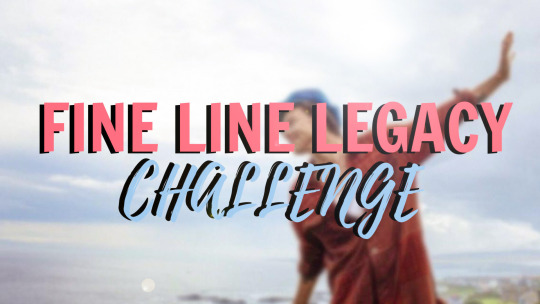
Sims 4 x Harry Styles 💓 Welcome to a legacy challenge inspired by various Harry Styles songs! This challenge was created by myself and my friend Amy because who doesn’t want to see this kind of crossover? This is a 10 generation legacy challenge with a threaded storyline inspired by songs off of Harry’s self-titled album “Harry Styles (2017)” and “Fine Line (2019)”.
Basic Rules:
You can select who will be the heir for the next generation. There are no restrictions on how many children each heir can have!
Unless exclusively outlined in a generation’s rules, you can marry or divorce whomever and do so as often as you’d like.
No money cheats can be used except for when you move in your very first heir in Generation One (freerealestate on).
You MUST complete all aspects for each generation before moving to the next one.
It is up to you whether or not you want aging on or what lifespan you wish to play on (playing on the normal lifespan could be an added challenge!).
There is an optional aspiration to complete for each generation.
If you choose to play this legacy challenge, post using the hashtag #finelinelegacy for us to see! 💓
Gen 1. "Carolina"
You left your small hometown for the big city of San Myshuno. Having grown up under your grandmother's roof with few simoleons to go around, you are pining for excitement, adventure, and a chance to make it big and become a star. As a Young Adult, you packed your bags and rented a "needs TLC" apartment in the Arts District.
Traits: Ambitious, Bookworm, Creative Aspiration: World Famous Celebrity Career: Musical Genius
Rules:
Reach Level 10 of the Entertainer Career (Musician Branch)
Complete the World Famous Celebrity
Reach Level 10 of the Guitar and Piano skills
Reach Level 5 of the Singing skill
Must start in a needs TLC apartment in San MyShuno
OPTIONAL: Complete the City Native Aspiration
--------------------------------------------------------
Gen 2. "Kiwi"
You grew up around fame and fortune, but it has left you feeling a bit empty and unfulfilled. Determined to make a name for yourself and step out from your parent's shadow, you've decided to pursue a different craft - acting. You really love cacti and the color black.
Traits: Non-Committal, Hot-Headed, Self-Absorbed Aspiration: Master Actress/Actor Career: Actor
Rules:
Reach Level 10 of the Actor Career
Complete the Master Actress/Actor Aspiration
Reach Level 10 of the Charisma and Acting skills
Reach Level 5 of the Baking skill
Have at least ONE (1) child out of wedlock
OPTIONAL: Complete the Party Animal Aspiration
--------------------------------------------------------
Gen 3. "Sweet Creature"
After having been in the public eye your whole life, surrounded by scandal, you seek simplicity, tranquility, and a way to plant new roots for your family. Speaking of family, you feel quite distant from your parents and hope to foster a strong bond with your own children. You always put family first, though your marriage may suffer some strain.
Traits: Family-Oriented, Loner, Cheerful Aspiration: Big Happy Family Career: Education (Professor Branch)
Rules:
Reach Level 10 of the Education Career (Professor Branch)
Complete the Big Happy Family Aspiration
Reach Level 10 of the Research & Debate and Charisma skills
Reach Level 5 of the Logic and Gardening skills
Sustain a garden of at least five (5) unique plants of Great quality
OPTIONAL: Complete the Soulmate Aspiration
--------------------------------------------------------
Gen 4. "Golden"
You always knew you were destined for greatness. Your intellect has opened many doors for you, but led you to a very strange place...Strangerville. Material things mean very little to you and you love the idea of being a bit more "off the grid," and self-sufficient.
Traits: Genius, Clumsy, Maker Aspiration: Outdoor Enthusiast Career: Detective
Rules
Reach Level 10 of the Detective Career
Complete the Outdoor Enthusiast Aspiration
Complete the Strangerville Mystery story-line
Reach Level 10 of the Fitness and Fishing skills
Reach Level 5 of the Herbalism skill
OPTIONAL: Complete the Angling Ace Aspiration
--------------------------------------------------------
Gen 5. "Sign of the Times"
After your parents' encounter in Strangerville, you became fascinated by aliens, space, and everything science-y. You know there is more to find out there. but first you need to learn everything you can about the unknown. A bit of an oxymoron, isn't it? When you're not fixated on the stars, you love to dance, tinker, and spend time with your many friends.
Traits: Geek, Dance Machine, Perfectionist Aspiration: Friend of the World Career: Engineer (Mechanical Engineer Branch)
Rules
Reach Level 10 of the Engineer Career (Mechanical Engineer Branch)
Complete the Friend of the World Aspiration.
Reach Level 10 of the Rocket Science, Programming, and Robotics skills
Reach Level 8 of the Handiness skill
Travel to Sixam at least one (1) time using a rocket you constructed
OPTIONAL: Complete the Renaissance Sim Aspiration
--------------------------------------------------------
Gen 6. "Two Ghosts"
Ever since you were a child, you knew you were different. You had numerous paranormal experiences, which has led you to dedicate your life to the paranormal altogether. You purchased a haunted house to try and get closer to the "other side," however this has left you feeling a bit emotionally burdened and isolated from those around you. You're reasonably covered in tattoos and are known to always wear a simple, white shirt. You hope to one day form a "Seance" club.
Traits: Adventurous, Gloomy, Good Aspiration: Bestselling Author Career: Freelancer (Paranormal Investigator Branch)
Rules
Complete 10 "Expert Paranormal Investigation" events in the Freelancer Career (Paranormal Investigator Branch)
Complete the Bestselling Author Aspiration
Reach Level 10 of the Writing and Medium skills.
Befriend both Guidry and Temperance
OPTIONAL: Complete the Leader of the Pack Aspiration
--------------------------------------------------------
Gen 7. "Watermelon Sugar"
You are a very health-conscious sim. Due to your love of animals, you have embraced a vegetarian lifestyle. Protecting the earth and nature is your number one goal in life, aside from ensuring justice is upheld in the courtroom and you are a top tier parent. You favorite fruit is watermelon and you farm your very own watermelons!
Traits: Vegetarian, Green Fiend, Dog Lover Aspiration: Friend of the Animals Career: Law (Judge Branch)
Rules
Reach Level 10 of the Law Career (Judge Branch)
Complete the Friend of the Animals Aspiration
Reach Level 10 of the Pet Training and Juice Fizzing skills
Reach Level 5 of the Parenting skill
Make your neighborhood's Eco Footprint Green for an entire sim year (4 seasons)
OPTIONAL: Complete the Super Parent Aspiration
--------------------------------------------------------
Gen 8. "Sunflower, Vol. 6"
Zen. That is what you embody. Where do you feel most zen? At the beach. This is why you live off the grid in Sulani. You practice yoga daily and find a great deal of joy in cooking homemade meals. In your spare time, you dabble in photography and painting. You love sunflowers and have them growing all around your home.
Traits: Foodie, Child of the Ocean, Art Lover Aspiration: Eco Innovator Career: Civil Designer (Green Technician Branch)
Rules
Reach Level 10 of the Civil Designer Career (Green Technician Branch)
Complete the Eco Innovator Aspiration
Reach Level 10 of the Gourmet Cooking and Wellness Skills
Reach Level 5 of the Photography and Fabrication skills
Marry a mermaid!
OPTIONAL: Complete the Painter Extraordinaire Aspiration
--------------------------------------------------------
Gen 9. "Canyon Moon"
Having grown up in Sulani, you're not sure how you ended up in quintessential suburbia outside a large city with a corporate job. Life is comfortable, but it lacks the excitement it once had. You want to travel, see the world, and learn about difficult cultures! You love to document your travels and share them online. Sometimes, you can be a bit neglectful of your responsibilities.
Traits: Kleptomaniac, Childish, Self-Assured Aspiration: Archaeology Scholar Career: Business (Investor Branch)
Rules
Reach Level 10 of the Business Career (Investor Branch)
Complete the Archaeology Scholar Aspiration
Reach Level 10 of the Selvadoradian Culture and Mixology skills
Reach Level 5 of the Media Production skill
Vacation at least once in each world!
OPTIONAL: Complete the Jungle Explorer Aspiration OR Mt. Komorebi Sightseer Aspiration
--------------------------------------------------------
Gen 10. "Fine Line"
You were definitely the class clown whilst in school. It was a way to cope with your insecurities, which you haven't been able to shake into adulthood. Nevertheless, your charm and strategic-timing have served you well in your "work," whatever that may be. You know there is always a fine line between life and death, you really live life on the edge.
Traits: Jealous, Goofball, Paranoid Aspiration: Public Enemy Career: Criminal Career (Boss Branch)
Rules
Reach Level 10 of the Criminal Career (Boss Branch)
Complete the Public Enemy Aspiration
Reach Level 10 of the Programming and Comedy skills
Reach Level 5 of the Rock Climbing skill
Graft a Death Flower to cheat death!
OPTIONAL: Complete the Fabulously Wealthy Aspiration
#misssimreno#thesims4#sims4legacy#legacychallenge#thesimslegacy#legacy#fineline#harrystyles#harrystylessims#sims4harrystyles
444 notes
·
View notes
Text
My art teacher once told me the key to getting better at drawing wasn't to train the hand, but to train the eye. What she meant was that you can practice as much as you want but if you can't learn how to actually observe, you're not going to make any progress. I apply that to writing as well - real life is one of the best references. Pay attention to the flow of conversations you have with other people, or listen to other people talk. What does that look like? People talk over each other all the time, and they repeat themselves and talk in circles and rarely say things directly. But you also don't want your characters saying "uh..." and "like" and "er..." four times in one sentence like real people do, so you need to strike a balance between making your dialogue believable but also not uncomfortable to read, and that's where you can go to fiction for help. Find movies or books with great dialogue and pay attention to what works, or better yet, find movies or books with awful dialogue and observe what DOESN'T work. You can apply that to anything in your writing - exposition, pacing, scene structure etc - if you can't find it irl, you can find it in books and movies. With fanfiction, you have the advantage of having already established characters with their own behaviors and ways of communicating so you can rewatch their scenes as many times as you need in order to get their vibe. I.e do they tend to lie? Are they brutally honest? Are they careful with their words? Do they speak softly or roughly? Do they talk in circles or more directly? How concisely do they explain things? Do they use simple or complex language? What interjections and expressions do they tend to use most?
As for more technical stuff like keeping a consistent tense, I recommend either using a program like Grammarly to help identify your mistakes (I use it a lot because english is not my first language and I don't feel fully confident in it), or ask a friend to beta read for you and give you a hand! But I mostly just recommend reading more professionally-published books. The more experience you have with the written medium, the better you'll become at it. After reading a lot of good and bad books and paying attention to what works and what doesn't, a lot of things will become second nature to you. You won't even realize you're doing a lot of the same things you used to think about a lot.
Other than that, just remember you don't need to "copy" anyone else's style to be a good writer. It's great to learn from writers you admire, but don't beat yourself over not being the same as them. Your style is yours, and you need to develop it in its own unique way. Just keep on writing and try to push your limits, identify what works and what doesn't and work on developing your eye before anything else.
I also recommend checking out the YouTube channel "hellofutureme", it has a lot of great writing advice, I think I rewatched the video on how to write first chapters a million times already - it's really good, it'll probably help you a lot. Good luck!
does anybody have any advice on writing fanfiction, specifically on creating a better flow between dialogue, action, and the story itself? i feel like i struggle with flowing between what the characters are saying and what's going on, and their thoughts. I have ideas and then i write them out or rough draft, but it always feels so robotic? idk if it's my autism or what, but i'll try looking at fics i love for examples or to try and emulate their style and i still feel like i can't get it right. I also struggle with keeping things past or present tense and it stresses me out. will gladly take ANY advice. i have so many half written fics because i get so frustrated i don't want to go back to them.
24 notes
·
View notes